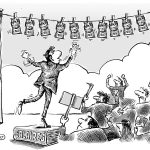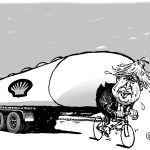My fair share
Temporary or more structural: is it the return of the price/wage spiral?
We had almost forgotten the term: the strike (or its threat) is back. In the United States, agricultural machinery manufacturer John Deere, hospital staff in New York and elsewhere, and the 60,000 technicians in Hollywood have launched are demanding immediate wage increases of 5% to 6% or more – which some have already obtained. In Germany, too, a country of trade union moderation, this year’s wage negotiations are expected to be tenser for the first time in many years. Following the shortage of truck drivers in the United Kingdom, Prime Minister Boris Johnson promises increases in wages, productivity and skills. In the wake of the recovery in activity, the labour market is under stress everywhere. To the point of seeing a new wage/price spiral begin?
In the United States, more than 10 million job offers are not filled. Some sectors, such as catering or healthcare, are understaffed. Border closures due to the pandemic have reduced temporary mobility, and migration. Against this backdrop, wage demands reflect a clear change in the economic balance of power. Will we go beyond simply catching up with the economic situation? The answer depends on at least two other parameters: the evolution of productivity and the sharing of added value.
Faced with wage demands, some companies will be able to transfer increases in their selling prices. Others will cut back on their margins. In which case they risk being penalized on the stock market. Price makers will be able to cushion the impact of cost increases in their accounts; on the other hand, the magnitude of these movements is likely to trigger a more marked inflationary spiral.
The lack of manpower is expected to play in favor of wage increases, adding to the dilemma of Central Banks in the face of the risk of seeing price increases accelerate and continue.
The pandemic had temporarily accelerated labour productivity. The recovery of activity tends to slow it down. In the United States since 2016, productivity has accelerated sharply, from 0.7% to nearly 3% per year. In Europe, the increase was less marked, but nevertheless on the rise. Recent surveys seem to indicate an improvement in productivity related to the use of telework (less transportation, more productive effective time). Lack of industrial capacity and relocation needs could accelerate robotization, which is now as necessary as it is affordable.
Always in the United States since 2016, average hourly wages have again increased by more than 2.5% per year (up to more than 4% per year in recent months); however, the share of wages in value added has remained rather stable. In Europe, the share of wages in value added fell sharply from 2015 to less than 60% in industry (against 71%). It could start to grow again without harming the profitability of companies.
While the participation rate in employment remains below pre-crisis levels, the lack of manpower should play in favor of wage increases, adding to the dilemma of Central Banks in the face of the risk of price increases accelerating and continuing.
For the time being, the monetary authorities are counting on the temporary and limited nature of these catch-ups – as in the case of energy price increases – which will attract more candidates to employment, especially as exceptional support measures for unemployment will gradually stop. So, in France, will the government’s decision to implement the unemployment reform contribute to this moderation in the medium term?
In the meantime, the Philips curve could well mark its great return in our studies.
Valérie Plagnol – October 19, 2021 – Published in French in www.allnews.ch – Cartoon ©Barret



